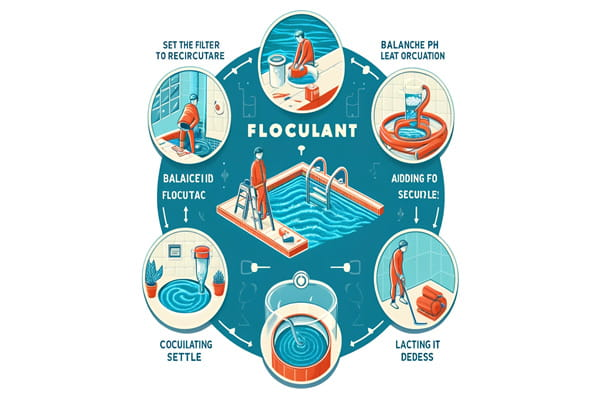As summer rolls in, nothing beats the joy of a pristine, crystal-clear swimming pool. However, keeping the water free from cloudiness and debris can be a daunting task. That’s where swimming pool flocculants come into play. These chemical helpers are key to maintaining the clarity of your pool when regular filtering just doesn’t cut it. Let’s dive into how these powerful agents work to keep your swimming oasis spotless!

I. What Are Flocculants?
- Flocculants, sometimes referred to as pool floc, are chemicals added to the swimming pool to enhance the cleanliness of the water. These substances are designed to clump together the tiny, buoyant particles that are too small and light,to settle at the bottom of your pool and be removed by vacuuming. These particles often consist of bacteria, virus particles, algae spores, and other microscopic debris.
- Despite the hard work of pool filters, some particles are so fine that they remain suspended in the water, causing cloudiness. When you pour flocculants into your pool, they act like a magnet, pulling these fine particles together into larger, heavier clusters. These clusters then sink to the bottom of the pool, where they can be easily vacuumed away, or let a robotic pool cleaner do the job if you prefer to relax and enjoy your summer.
II. How to Use Swimming Pool Flocculants?

1. Set Filter to Recirculate
Before adding flocculant, switch your sand filter or DE filter multiport valve to “recirculate.” This prevents the flocculant from entering the filter system, which could clog and potentially damage it, requiring a complete replacement of the filter medium.
2. Balance pH
Ensure the pH of your pool water is between 7.4 and 7.6. Test the water levels and adjust using a pH increaser or decreaser as needed to achieve the ideal range.
3. Add Flocculant to Pool Water
Calculate and measure the correct amount of flocculant based on your pool’s volume. Use a pool volume calculator if necessary. Always follow the manufacturer’s instructions closely when adding any chemical to your pool.
4. Circulate the Flocculant
Run your pool pump for about two hours to thoroughly distribute the flocculant throughout the pool. Keep your filter set to “recirculate” during this process to avoid clogging.
5. Let Pool Flocculant Settle
After circulating, turn off the pool pump and allow the flocculant to work undisturbed for at least eight hours, ideally overnight. Disable any automatic timers to ensure the pump remains off during this period.
6. Vacuum Particle Clumps Out of Pool
Switch your pool filter to “Waste” and connect your manual vacuum. If your system lacks a multiport valve, open the drain port to let water out as you vacuum. Vacuum slowly to avoid stirring up the sediment again. If the water becomes cloudy, pause to let it settle before resuming. You might need to vacuum multiple times to remove all the particle clumps effectively.
7. Check Pool’s Water Level
Vacuuming and draining may reduce the water level. Use a garden hose with a filter to refill your pool to the proper level. To minimize disturbance to the settled particles, avoid adding water while vacuuming, unless necessary.
8. Test and Balance Water
After adjusting the water level, retest your pool’s water chemistry. Correct the alkalinity and pH levels first, then add chlorine as required. Ensure the filter system is running normally during this rebalancing process to aid in the even distribution of chemicals.

III. Frequently Asked Questions
1. Can you swim in cloudy pool water?
It’s not advisable to swim in cloudy pool water as it’s filled with contaminants that can irritate your eyes and skin. The reduced visibility also increases the risk of drowning. Always wait until the water is clear.
2. When should I add flocculant to my pool?
Add flocculant if your water is cloudy and the chemical balance (pH, alkalinity, and chlorine levels) is correct and your filter is clean. It’s also beneficial to use after a storm or in the early stages of algae development. Since flocculants take 8 to 16 hours to work, adding them at dusk and allowing them to work overnight is ideal.
3. Can I use algaecide and flocculant together?
Do not mix algaecide and flocculant at the same time. However, flocculant is useful in the early stages of fighting algae growth as it helps bind floating algae particles, making them easier to remove.
4. Can I use aluminum sulfate as a pool flocculant?
Yes, aluminum sulfate (also known as alum) can be used. Ensure it’s of food-grade or garden-grade quality. Adjust the amount based on your pool’s condition—about 4 pounds per 10,000 gallons of water.
5. Can you use too much flocculant?
Yes, using too much flocculant can actually make your pool water cloudier. Like any other chemical, follow the manufacturer’s instructions and adjust the dosage according to your pool’s volume.
IV. Conclusion
Understanding how swimming pool flocculants work, and using them correctly, can significantly improve the clarity and quality of your pool water. By following the steps outlined above, you can ensure that your pool remains a delightful retreat throughout the swimming season.
